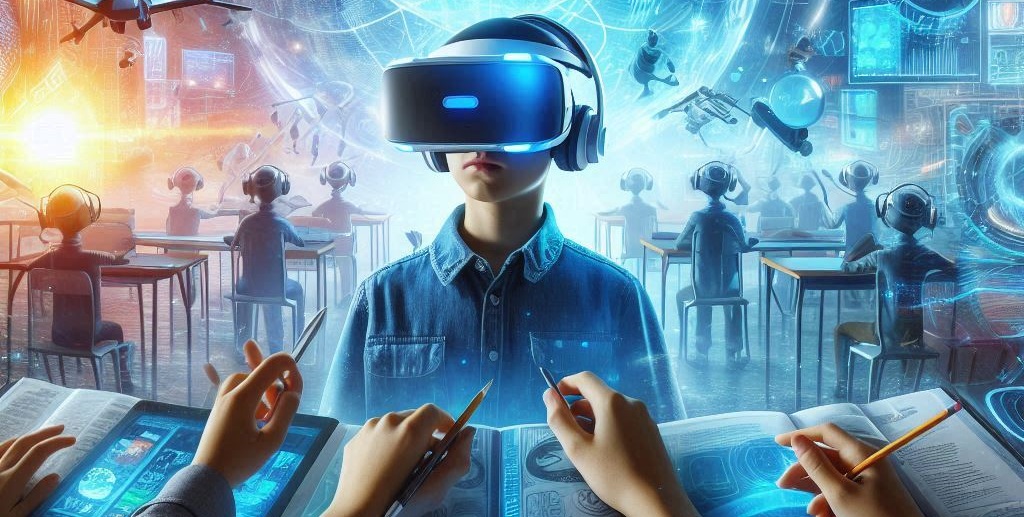Virtual reality (VR) technology has been rapidly evolving, transforming how we experience entertainment and education. Initially seen as a niche technology for gaming enthusiasts, VR has now penetrated multiple sectors, and its potential seems boundless.
Whether it’s for immersive storytelling, lifelike simulations, or innovative educational tools, VR is shaping the future in profound ways.
Read More: The Evolution of Mobile Technology: From Brick Phones to Smartphones
In this article, we’ll explore the role of virtual reality in entertainment and education and look at how this technology will revolutionize both industries in the years to come.
The Evolution of Virtual Reality Technology
VR’s journey began decades ago, with rudimentary forms of immersive experiences created in the 1960s. However, technological limitations prevented it from reaching mainstream popularity.
It wasn’t until recent advancements in computer graphics, processing power, and motion tracking that VR became a practical, immersive experience. Companies like Oculus (now part of Meta), HTC, and Sony developed sophisticated VR headsets that allowed users to step into virtual worlds with realistic visuals and responsive interactivity.
Today, VR headsets like the Oculus Quest 2 and PlayStation VR are accessible and affordable, bringing the promise of VR to a global audience. However, the potential of VR stretches far beyond gaming.
With its ability to simulate realistic environments and experiences, VR is poised to transform both entertainment and education in ways that could change how we consume content and learn.
Virtual Reality in Entertainment: Immersion and Interactivity
Entertainment is one of the most popular and obvious uses for virtual reality. In gaming, VR provides an unprecedented level of immersion, allowing players to feel as if they are physically inside the game world.
However, VR’s entertainment applications are not limited to just gaming. The future of VR in entertainment spans across multiple sectors, including movies, music, social interaction, and live events.
a. Immersive Storytelling in Movies and TV
VR is redefining how stories are told in film and television by enabling viewers to become active participants in the narrative. Traditional films are experienced passively, with the audience observing from a distance.
In VR, users can immerse themselves in the story’s world, exploring different perspectives and interacting with the environment. Directors and filmmakers are experimenting with 360-degree storytelling, where the audience can look in any direction and uncover hidden elements of the story.
As VR technology continues to advance, we may see a future where watching a movie becomes an interactive experience, with viewers choosing different plot directions and outcomes based on their decisions.
Virtual reality has the potential to blur the line between movies and video games, creating a new hybrid form of entertainment that offers personalized, immersive experiences.
b. Music and Concerts in VR
The music industry is also exploring the possibilities of VR technology. Artists are using VR to create virtual concerts, allowing fans to attend live performances from anywhere in the world.
These concerts provide a sense of presence and interactivity that traditional streaming platforms can’t match. Fans can explore virtual venues, interact with other attendees, and experience the concert from different angles.
VR concerts became especially popular during the COVID-19 pandemic when live performances were suspended. Platforms like Wave, AltspaceVR, and Oculus Venues hosted virtual events that allowed artists to connect with their audiences in new ways.
As technology improves, VR concerts may become a standard way for fans to experience music, offering greater accessibility and innovative ways for artists to engage their audiences.
c. Social Experiences and Virtual Worlds
Another exciting frontier for VR in entertainment is social interaction. Platforms like Meta’s Horizon Worlds and VRChat enable users to create avatars and interact with others in virtual environments. These virtual worlds allow users to socialize, attend events, and even create their own content, blurring the line between entertainment and social networking.
As VR technology continues to evolve, we can expect more immersive social experiences where users can form genuine connections and build communities in digital spaces. These platforms could become a mainstream method for socializing, entertainment, and even work collaboration as VR adoption grows.
Virtual Reality in Education: A New Era of Learning
While entertainment often steals the spotlight when it comes to virtual reality, its impact on education is perhaps even more transformative. VR has the potential to revolutionize the way we learn by making education more immersive, interactive, and engaging. In contrast to traditional classroom methods, VR can provide students with hands-on experiences that foster deeper understanding and retention of knowledge.
a. Immersive Learning Environments
One of the key benefits of VR in education is its ability to create immersive learning environments. Imagine studying ancient history by virtually exploring the ruins of ancient Rome or learning about marine biology by diving into the depths of the ocean, all from the safety of a classroom. VR can simulate environments that would otherwise be difficult, expensive, or impossible to experience in real life.
Immersive learning environments allow students to engage with their subject matter in a way that textbooks and lectures simply cannot replicate. By interacting with virtual objects and exploring dynamic environments, students can develop a more comprehensive understanding of complex topics.
For example, medical students can use VR to practice surgical procedures in a risk-free environment, while engineering students can experiment with designs and structures without needing physical resources.
b. Enhancing Student Engagement
Another key advantage of VR in education is its ability to enhance student engagement. Traditional teaching methods often struggle to hold the attention of today’s tech-savvy students, but VR offers a dynamic and interactive learning experience that captivates learners. By making lessons feel more like an adventure or game, VR can make learning fun and exciting.
For instance, VR can gamify the learning process by incorporating elements of storytelling, problem-solving, and competition. In a virtual history lesson, students might participate in a simulation where they take on the role of historical figures, making decisions that impact the course of events. This type of active participation fosters a deeper connection with the material, leading to better retention and a more enjoyable learning experience.
c. Expanding Accessibility to Education
VR also has the potential to make education more accessible to a wider audience. One of the challenges in education is the disparity in resources between different schools and regions.
Many students around the world lack access to high-quality learning materials, experienced teachers, or specialized facilities. VR can bridge this gap by providing students with access to world-class educational content, no matter where they are.
For example, virtual classrooms can connect students from different parts of the world, allowing them to attend lectures from renowned professors, participate in collaborative projects, or take virtual field trips to distant locations.
This democratization of education through VR has the potential to level the playing field and provide students with opportunities that would otherwise be out of reach.
d. Training and Simulations
VR is also proving to be a valuable tool for training and simulations in a variety of fields. In industries like healthcare, aviation, and the military, VR can simulate real-world scenarios, allowing trainees to practice their skills in a safe and controlled environment.
For instance, pilots can use VR flight simulators to practice takeoffs, landings, and emergency procedures, while surgeons can perform virtual surgeries to hone their techniques before working on real patients.
This type of experiential learning is particularly beneficial in high-risk professions, where mistakes can have serious consequences. By using VR simulations, trainees can build confidence and competence without the risk of harming others or damaging equipment.
Challenges and Considerations for VR in Entertainment and Education
While VR holds tremendous promise for both entertainment and education, there are still challenges that must be addressed before it reaches its full potential.
a. Cost and Accessibility
One of the primary barriers to widespread VR adoption is the cost of the technology. While VR headsets have become more affordable in recent years, they are still out of reach for many individuals and institutions. Additionally, the hardware requirements for running high-quality VR experiences can be demanding, requiring powerful computers or gaming consoles.
As technology advances and production costs decrease, it’s likely that VR will become more accessible to a broader audience. However, for now, affordability remains a challenge that needs to be addressed for VR to achieve mainstream success in both entertainment and education.
b. Motion Sickness and Physical Discomfort
Another challenge with VR is that some users experience motion sickness or physical discomfort after prolonged use. The disconnect between what the eyes see and the body’s physical sensations can cause nausea and dizziness, limiting the amount of time users can spend in virtual environments.
Developers are working on reducing latency and improving the refresh rates of VR headsets to minimize these effects, but it remains an ongoing concern.
c. Content Creation and Availability
While VR offers exciting possibilities, the development of high-quality VR content is still in its early stages. Creating immersive VR experiences requires significant time, resources, and expertise, which can be a barrier for content creators. Additionally, there is currently a limited selection of VR content, particularly in education, compared to more established forms of media.
As the industry grows and more developers embrace VR, we can expect an influx of new content that will further drive adoption and innovation in both entertainment and education.
Conclusion
The future of virtual reality technology in entertainment and education is incredibly promising. In entertainment, VR is enhancing immersion and interactivity, allowing users to participate in stories, attend virtual concerts, and engage in social experiences like never before.
In education, VR is transforming the way we learn by creating immersive environments, boosting student engagement, and providing hands-on training through simulations.
While there are challenges to overcome, such as cost, motion sickness, and content creation, the potential of VR to reshape both industries is undeniable.
As technology continues to advance, we can expect virtual reality to play an increasingly central role in how we experience entertainment and education, opening up new possibilities for creativity, learning, and connection.








